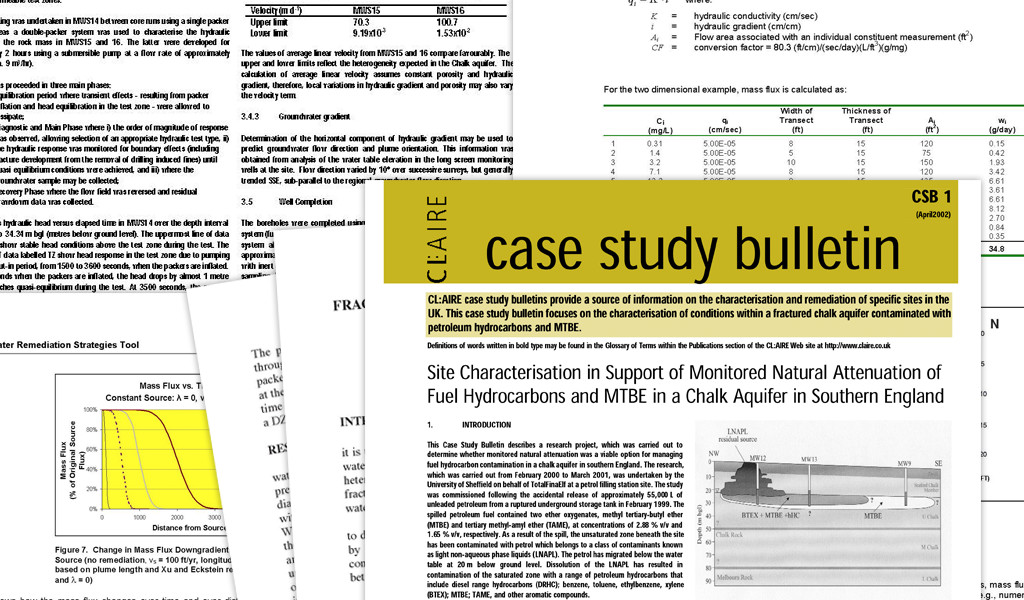Groundwater Remediation Strategies Tool. American Petroleum Institute Publication #4730, December 2003
This guideline, prepared for the American Petroleum Institute, suggests methods to focus remediation on changes in mass flux and remediation time. The use of Multilevel well transects is a recommended method to provide detailed 3 dimensional plume characterization to use in the calculation of mass flux at a monitoring site.
Ground water monitoring: Some current deficiencies and alternative approaches. Cherry, 1993.
In this paper, Dr. John Cherry from the University of Waterloo describes the spatial complexity of dissolved contaminant plumes and stresses the need for new monitoring approaches and technologies to characterize them.
Complete citation: Cherry, J.A. 1993. Ground water monitoring: Some current deficiencies and alternative approaches. In Hazardous Waste Site Investigations; Toward Better Decisions, edited by Gammage, R. B. and B. A. Berven. Lewis Publishers.
Importance of close-interval vertical sampling in delineating chemical and microbiological gradients in ground-water studies. Smith et al., 1987
In this landmark paper, researchers from the USGS review the findings of their natural-gradient tracer test in Cape Cod, Massachusetts. They document strong vertical variation in the concentrations of dissolved solutes and the limited vertical mixing that occurs in the aquifer. They stress the need for closely-spaced depth-discrete sampling points for accurate characterization of dissolved plumes.
Complete citation: Smith, R.L., R.W. Harvey, J.H. Duff, and D.R. LeBlanc. 1987. Importance of close-interval vertical sampling in delineating chemical and microbiological gradients in ground-water studies. USGS. Open File Report 87-109. B33-B35 pp.
Technical Bulletin: Site Characterisation in Support of Monitored Natural Attenuation of Fuel Hydrocarbons and MTBE in a Chalk Aquifer in Southern England
This Case Study Bulletin describes a research project, which was carried out to determine whether monitored natural attenuation was a viable option for managing fuel hydrocarbon contamination in a chalk aquifer in southern England. The research, which was carried out from February 2000 to March 2001, was undertaken by the University of Sheffield on behalf of TotalFinaElf at a petrol filling station site. The study was commissioned following the accidental release of approximately 55,000 L of unleaded petroleum from a ruptured underground storage tank in February 1999.
Acknowledgement: This work was carried out by Dr Steve Thornton and Mr Gary Wealthall at the Groundwater Protection and Restoration Group, Department of Civil and Structural Engineering, University of Sheffield on behalf of TotalFinaElf. Dr Steve Thornton may be contacted at: University of Sheffield, Groundwater Protection and Restoration Group, Dept. of Civil and Structural Engineering, Mappin Street, Sheffield S1 3JD Tel: 0114 222 5744 Fax: 0114 222 5700 Email: [email protected] Mr Gary Wealthall, formerly of University of Sheffield may be contacted at: British Geological Survey, Environment and Hazards Directorate, Keyworth, Nottingham NG12 5GG Tel: 0115 936 3541 Fax: 0115 936 3261 Email: [email protected]
Implications of observed and simulated ambient flow in monitoring wells. Elci et al., 2001
The authors of this paper present compelling evidence that conventional monitoring wells act as vertical conduits whenever vertical hydraulic gradients are present (i.e., at most sites). Vertical flow within wells due to natural hydraulic gradients not only makes it impossible to accurately define the vertical distribution of dissolved contaminants within the aquifer, but it can transport contaminants to portions of the aquifer that were previously uncontaminated. The authors state that “We must agree with the early warning of Reilly et al. (1989) to abandon or phase out the use of long-screened monitoring wells for ground water sampling.”
Complete citation: Elci, A., F. Molz, and W.R. Waldrop. 2001. Implications of observed and simulated ambient flow in monitoring wells. Ground Water 39, no. 6: 853-862.
Importance of discrete-zone monitoring systems in fractured-bedrock wells - A case study from the University of Connecticut landfill, Storrs, Connecticut. Johnson et al., 2001.
In this paper, scientists from the U.S. Geological Survey discuss the importance of depth-discrete monitoring of fractured rock aquifers. Depth-discrete monitoring is needed to determine hydraulic gradients, identify connections between transmissive zones, and to explore the potential hydraulic connection between fractured rock and surficial aquifers. The authors present results from their work at a site where CMT multilevel wells equipped with inflatable packers were used to monitor four discrete zones in each borehole.
Complete citation: Johnson, C.D., F.P. Haeni, and J.W. Lane. 2001. Importance of discrete-zone monitoring systems in fractured-bedrock wells -- A case study from the University of Connecticut landfill, Storrs, Connecticut. Paper presented at Symposium on the Application of Geophysics to Engineering and Environmental Problems (SAGEEP), March 4-7, 2001, in Denver, Colorado.
Use of Multilevel Systems to Support Programs to Manage Contaminated Groundwater. Beck, 2003.
"Cost effective management of contaminated groundwater is reliant on access to sufficient, good quality, reliable data developed from site characterization programs. The cost to acquire this data can be very expensive, therefore programs need to be well thought through before valuable resources are committed."
Petroleum Industry News, Annual Buyer’s Guide 2004, Vol 4 Iss 4. Pg 58-59. Published by International Labmate Ltd. October 2003


